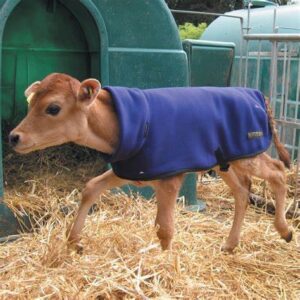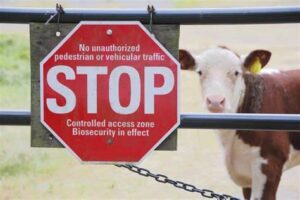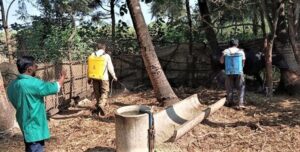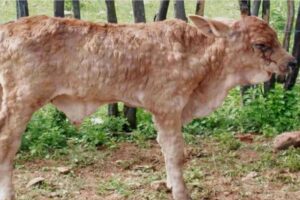Care and Management of Calf in Lumpy Skin Disease
Sagar M Patel1, Y. A. Pathan2, Jitendra Kurundwade3, Prakash Dhamannapatil1, Sagar Tagare1,
1Livestock Development Officer, Animal Husbandry Department, Kolhapur, Maharashtra, India
2District Deputy Commissioner, Animal Husbandry Department, Kolhapur, Maharashtra, India
3Assistant Commissioner, Animal Husbandry Department, Kolhapur, Maharashtra, India
Abstract
Lumpy Skin Disease (LSD) is an infectious, eruptive, occasionally fatal disease of cattle characterized by nodules on the skin and other parts of the body. Lumpy skin disease causes considerable economic losses in calves due to emaciation, hide damage, stunted growth, decreased feed conversion efficiency, and mortality. Incidence and mortality of Lumpy Skin Disease in cow calves is increasing in Gujarat, Rajasthan, Maharashtra, Karnataka, Himachal Pradesh, Panjab and Haryana states of India over the last three months. Therefore, measures should be implemented focusing mainly on calf feeding and shelter management, deworming, external parasite control and vaccination in order to maintain maximum immunity in calves.
Introduction
Lumpy Skin Disease (LSD) is an economically important viral disease of cattle and buffalo characterized by nodular skin lesions on different body parts. It is mainly caused by virus of the family Poxviridae, also known as Neethling virus. The virus has important economic implications since affected animals tend to have permanent damage to their skin, lowering the commercial value of their hide. Additionally, the disease often results in chronic debility, poor growth, sometimes death. Incidence and mortality of Lumpy Skin Disease in cow calves is increasing. Therefore, measures should be implemented focusing mainly on calf feeding and shelter management, deworming, external parasite control and vaccination in order to maintain maximum immunity in calves.
Fig. 1. Nodules all over the body of calf in Lumpy Skin Disease.
- Dietary Management
- Newborn calves should be fed with colostrum at 10% of their body weight within two hours of birth. So that the newborn calves will develop better natural immunity through colostrum
- Newborn calves should not be starved at any circumstances. Usually 10% of the weight of milk should be fed to calves regularly. Include protein-rich dicots fodder in the diet.
- Calves should be fed with calf starter rations from 4th week of age. Pre-biotic should be given in calf starter ration.
- Exposure of the calves to morning sunlight will be required for vitamin D synthesis and boost up immunity.
- Mineral mixture and vitamins should be given regularly to the calves.
- Shelter Management
- Due to changes in the environment like extreme cold or extreme humidity and heavy rainfall etc., the calf may in stressful condition and the immune system may decrease. Therefore, newborn calves should be protected from adverse environment.
- Warm and adequately ventilated shelter should be provided for newborn calves.
- New born calves should be kept in a warm place at night during winter days. If it is very cold, the body part of the calf should also be covered with warm clothes to protect the calf from the cold.
- Care should be taken that the sitting area of the calves or the clothing on them does not get wet.

Fig. 2. Protection of calf from cold climate.
- Biosecurity
- Newborn calves should be born in an aseptic environment.
- The umbilical cord of the newborn calf should be tied two inches from the body with a thread dipped in 2% povidine iodine and cut with a new blade leaving another inch before it.
- Newborn calves should be kept separate from adult animals to prevent transmission of LSD.
- New born calves should never be tied to wet, urine covered areas to avoid the possibility of infection.
- Premises of cowshed including saliva and nasal secretions should be disinfected daily by spraying 2% sodium hydrochloride solution or 3% phenyl solution. Care should be taken that this solution does not fall on the body of animals and calves should not be allowed to enter the cowshed for half an hour after spraying.
- Isolation and quarantine of affected calves from healthy calves.

Fig.3. Biosecurity measures in shed
- Deworming
- The parasitic load is higher in newborn calves which decrease their immune system and such calves are susceptible to infectious diseases like lumpy skin disease. Therefore, deworming (piperazine @ 200 to 300 mg per kg body weight, pyrental @ 250 mg per kg body weight or fenbindiazole @ 5 to 7.5 mg per kg body weight) should be done at 7th and 21 days after birth.
- Calves between 2-6 months of age become infected with tapeworms after eating pasture grass. During this period roundworm infestation is also seen in calves. Therefore, suitable anthelmintic (praziquantal + fenbendazole @ 15 + 5 mg per kg weight) should be given to eliminate the infestation of both these worms in calves of such age.
- Anticoccidial drugs (such as Ampralium @ 10 mg/kg body weight once daily for five days, or Monensin @ 1 mg/kg body weight) if bleeding occurs due to soil-licking habit in calves of 3-4 weeks of age once daily for three days) should be given.
- External parasite control
- Lumpy skin disease is mainly spread by ectoparasite lie ticks, flies and fleas.
- Waste material of cow shed should be collect and burn. The cracks and crevices of the cowshed should be burnt with a flame gun to prevent new generation of pests.
- If newborn calves are found to be infested with ectoparasite, clean the barn and spray the barn with 4% salt solution.
- Calves and cows should be sprayed with a botanical insecticide solution to eliminate blood-sucking flies and other insects. For this, mix 10 ml of neem oil, 10 ml of karanj oil, and 10 ml of eucalyptus oil and two grams of organic soap in 1 litre of water. Make a mixture of them and use it for spraying in the cowshed and on the body of the calves.
- Management of drainage of cowshed should be done to avoid breeding of pests.
- Dung from animal sheds should be regularly.
- The place of dung storage should be covered with polythene sheet.

Fig. 4. Spraying of insecticides in open shed of cattle.
- Preventive Vaccination
- Calves of all ages should be vaccinated against Lumpy Skin Disease, especially those that are unvaccinated or uninfected.
- Deworming a week prior to vaccination provides optimal immunity from vaccination.
- If pregnant cows are vaccinated, the newborn calf gets immunity from colostrum which lasts for 3 to 4 months of age.
- Awareness programme
- Mass awareness campaign to be taken up to make the public aware of the disease and report to the veterinary authority immediately when suspected cases are detected. This will help in prevention and control of LSD.
- Regular training and sensitization of veterinarians including awareness to animal owners and other stake holders should be enhanced on clinical presentation of the disease along with surveillance strategy and control measures.
Conclusion
Consequence of this disease is very important on the aspect of hide industry as it reduces the hide quality. High mortality rate in calves leads to huge economic losses to farmers. As LSD is a viral disease, no particular curative drug is there, but supportive therapy with antibiotics, antihistaminic, anti-inflammatory and multivitamins can give to avoid the further complication and saving the life. Along with supportive therapy, mortality of calves can be reduced with implementing good management practice with regards of calf feeding and shelter management, deworming, external parasite control and vaccination.
References
Directorate of Extension Education, Maharashtra Animal and Fishery Sciences University, Nagpur.
Field veterinarians and Expert veterinarians in LSD.
Lumpy Skin Disease in Cattle- MSD Veterinary Manual.
Lumpy Skin Disease in Cattle: Diagnosis and Treatment. Agricultural Guide.
Patel S. M., Thakor J. C., Dinesh. M., Sahoo M., Kumar A., Sahoo N. R and Mahajan S., (2021). Lumpy Skin Disease: An emerging threat to Cattle and Buffalo. Epashupalan, Issue 9, Vol 2.
Wikipedia and encyclopaedia.



